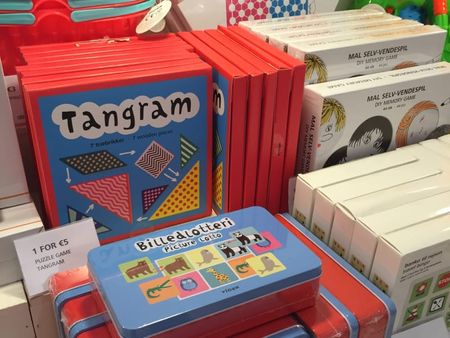The Fashionable Chinese Puzzle
The craze that swept Europe - and Dublin - 200 years ago
A wonderfully compelling puzzle can be constructed from a square of card, cut into 7 pieces, as illustrated below. Those 7 pieces can be reassembled into a myriad of shapes, some examples of which are shown. The game is simple: pick a shape and try to reconstruct it using all 7 pieces, without overlaps. It is surprisingly challenging.

If you would like to try the puzzle before reading any further, here's a printable PDF file from which you can cut out the pieces. There is also a set of sample patterns to construct... and the solutions if you get really stuck.
Tangrams, as they later became known, were the world's first puzzle craze, taking Europe by storm in 1817. They arrived on the same trading ships that were carrying the valuable commodities of tea, silk, porcelain and spices from Canton, China back to Europe. Who invented them is unknown though they most likely first appeared around 1800 in China, perhaps based on earlier dissection puzzles.
The tangram sets and Chinese books of tangram patterns were carried back to England and widely circulated. They really took off, however, after the publication of the first tangram book in English, in March 1817, called The Fashionable Chinese Puzzle.
The citizens of Georgian-era Dublin were also keen on the novel and exotic. This advertisement in the local Freeman's Journal on 19th June, 1817, announces the arrival of the new Chinese amusement:

It declares:
M and I Webb ... have also received a New Chinese Puzzle, being Bonaparte's favourite amusement at St Helena. This ingenious contrivance consists of seven pieces, is constructed on true geometric principles, and may be so disposed as to form upwards of 300 curious Figures.
- Freeman's Journal, 19th June, 1817
Napoleon's supposed fondness for the distraction had been mentioned in The Fashionable Chinese Puzzle, hence the brazen claim of his endorsement here. There is no evidence that he spent much time with it but many of his possessions from his time in exile remain in museum collections, and they do include a handsome carved ivory set of tangrams.
Other 19th century celebrities are known to have dabbled. Edgar Allen Poe had his own carved ivory tangram set. Lewis Carroll's library included The Fashionable Chinese Puzzle. The "Chinese puzzle" is employed as a simile in one of Hans Christian Andersen's tales, which surely indicates its familiarity to audiences of the time.
Tangram puzzles are still widely available, particularly in Asia. In 2017, exactly two hundred years after they were first advertised in a Dublin newspaper, I was able to walk into a shop in Dublin and buy a set of tangrams. Made in China, naturally, and a lovely echo of the Old China Trade.

Next: The Magnetic Epitaph